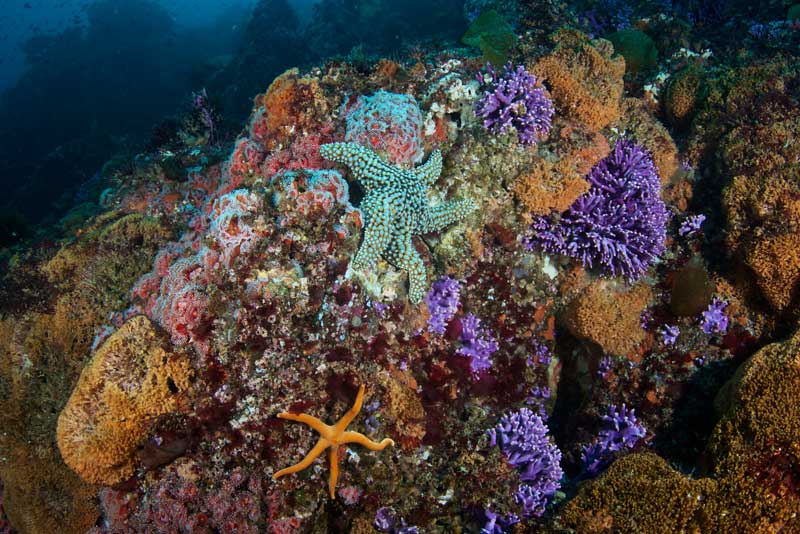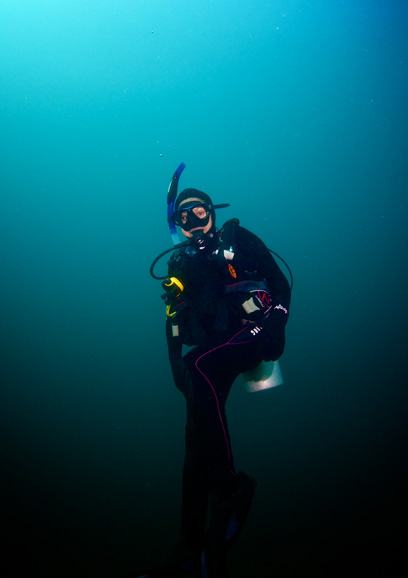Farnsworth Banks (sometimes called Farnsworth Pinnacles or Farnsworth Wall) lies in the open Pacific about five miles to the southwest of Catalina Island. It is a pristine set of pinnacles blossoming up from 200’ to their peaks at about 60’. Its depth makes it an advanced dive; its remarkable abundance of life makes it a reason to get your Advanced Open Water.
Story by Corey Schultz, photos by Dudley McLaughlin
Catalina Island itself is different on the windward side. The east side is covered in green scrub, through which red dirt trails cut horizontally. Watercraft are frequent white shapes against the red crags and semi-desert scrub. The west side, however, is a different island: greenish-silver and stark. The Pacific slivers into white against the steep cliffs, having met no land since Asia with the exception of tiny islands. It was an austere yet beautiful sight as we readied our dive gear.
The boat
We were the only dive boat in sight at 8:30 am Sunday. The morning’s fog was congealing into a low maritime layer, a gray ceiling capping the top of the island. There was no sign of humanity beside the westward of the Two Harbors, where you could see the white matchsticks of sailboat masts. As the day heated up, the maritime layer flattened into gray shreds.
Twenty-three divers had come out of Long Beach on the Cee Ray Dive Boat, which is harbored at Berth 55 and captained by Mike and Kim Lancaster. Many of us were from Long Beach’s Deep Blue dive shop, and we ranged in experience from new Advanced divers who had 25 dives to instructors with two or three thousand. Cee Ray is a wonderful dive boat; you come aboard the night before and sleep while the crew navigates into the Pacific. Kim is also the head chef, and no one on Cee Ray is ever in danger of starvation. Breakfast was banana pancakes, bacon and a jalapeno-and-ham quiche. For lunch we made burritos out of pulled pork, rice and beans and all the sides. The all-but-world-famous monkey bread (a sweet roll you can pull apart with your fingers) and fresh cantaloupe made an appearance during all surface intervals, and brownies with vanilla ice cream are served for dessert. “If you go hungry on Cee Ray,” said Capt. Kim. “It’s no one’s fault but your own!”
The dive
The life in Farnsworth’s protected waters is abundant and healthy. We descended down the anchor chain onto cliffs of purple hydrocoral. I also saw plenty of huge purple sea urchins, bi-colored male sheepshead wrasse, egg-shaped keyhole limpets and Spanish shawl nudibranchs. Blackish-red bat stars the color of charred brick were plastered to the pinnacles. The sheer profusion of life made this dive a treat. Yellow tail and calico bass flickered around as we circled the pinnacles. Though you can push the limits of recreational diving and descend to 130’, there is plenty to be seen in the 60-100’ range as well.
The conditions were extraordinary. “You might never see it like that again” said Aaron Goehring, a local dive instructor with Deep Blue. “No surge, no swell, amazing visibility and warmer than normal water. I’ve dived here six or seven times, and usually you are only getting two of those things if you’re lucky. Some treks out here are a leap of faith”.
“This is a phenomenal place to dive,” said Jay Canfield, a NAUI instructor, who has been to Farnsworth six times. “It is a treat to see the purple hydrocoral and the sun coral in California, and it’s thriving. This dive was the best one yet.”
At almost 90’ and diving on air, I was limited to only 25 minutes bottom time. From my 15’ safety stop I watched other divers deeper beneath the blue. They streamed columns of silver bubbles. Small bubbles and large silver half-domes like jellyfish shivered up through the turquoise. The water was as clear as an aquarium tank; you could see the entire anchor chain from 65’ up to the Cee Ray.
Now, the downside: on this dive I saw no electric rays, giant bass, bat rays or marine mammals except for one harbor seal inspecting the Cee Ray before we dropped anchor. This is not to say these creatures aren’t out there –I just didn’t see them this time. A reason to come back.
If you want to dive Farnsworth
1.) Get your Advanced Open Water qualification to handle the depth and the current.
2.) Go with someone who’s been there before. In low visibility, the anchor chain can be difficult to find. You don’t want to miss it, run low on air, and have to surface in the open ocean.
3.) Be prepared to return. As Farnsworth Banks lies on the windward side of Catalina, the conditions are dependent on the whim of Mother Ocean.
4.) Bring a camera!
5.) Consider diving on NITROX instead of air to increase your bottom time.
The Stats:
Date: February 15, 2015
Air Temp: 61F at 9 am
Surface Temp: 58F
Bottom Temp (89’): 55F
Visibility: 100+
Surge: Minimal
Enjoyment: Record!
Finding Farnsworth:
Waypoint: FRNWOR
Latitude: 33.3391666666667, N 33 20.350
Longitude: -118.5175, W 118 31.050
(Source for location: http://www.divespots.com/scuba-diving-spots/california/san-diego/spots/farnsworth-bank)
Story by Corey Schultz, photos by Dudley McLaughlin



